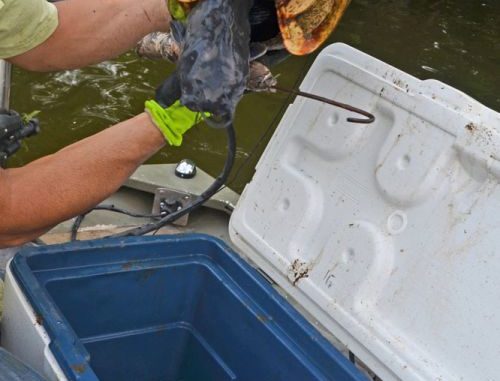
Make a small gaff hook to use to pull stubborn fish from their bottle. “Sometimes I wonder how the fish get in the bottle when I can hardly get them out,” mused Gremillion.
“At times I have to break all three fin spines, by twisting each spine with the crook in the gaff. Usually though, I gaff them under the chin to pull them out straight.”
His gaff is made of stiff wire set into a wood handle, all taped together with duct tape. The outer tip end of the wire is heavily bent backwards. The gaff’s total length is 14 inches.
“You will get dirty, wet and slimy doing this,” cautioned Gremillion.
So wear appropriate clothes or slicker pants. Gremillion wears white rubber fisherman’s boots, both to keep his feet dry and because they protect his feet from fish spines better than Crocs or sandals. “This is not sandal fishing,” he emphasized.
Gloves are important, not so much to protect the hands from fish spines, but rather because they help in retrieving the float line and prevent many nicks and abrasions that rusting metal bottles can inflict.
You will want an easy-to-clean boat noted Ramagos, one with no carpet. “An aluminum boat with a hard floor is easy to wash and drain,” added Gremillion. “I say ‘leave your bass boat at home and take your neighbors bateau (flatboat).’”
Season the bottles you plan to use at least a month before you plan to use them by soaking them in the water to be fished. “This allows slime growth to occur inside the bottles,” explained Gremillion. “Catfish don’t want to use unseasoned bottles. After one month, run them and empty the silt out of them and they are ready to fish.”
Partner up with another recreational gear license holder. A Pipes/Drums Recreational Gear License is required in addition to a Basic Fishing License to run bottles. The $10 license allows the use of five bottles. Two license holders teaming up in one boat can run 10 bottles instead of five. Commercial licenses allows the use of unlimited numbers, but cost substantially more.
Time your bottle fishing for the best months of the season. Although catfish spawn from May through August, Gremillion believes that fishing is most productive in June. Earlier than June, the bottles hold mostly males preparing the spawning site. In June, a male and a female fish are often found in one bottle.
Later in the year, mostly males are found solo in the bottles. “They are nothing but head,” he grimaced. “Their bodies are run down. They don’t look like the pretty fish caught earlier in the year.”
For better control, run bottles with the bow of the boat facing upwind when possible. Gremillion says that while a trolling motor is quieter, bottles may be run using the boat’s gasoline engine.
“I don’t find that noise affects the fish. But if you hit the bottle with a paddle or your motor’s lower unit, the fish will leave.”
Don’t dawdle when retrieving a bottle. With the boat directly over the bottle, it should be retrieved with a swift upward pulls of the cord. Cover the hole as soon as it breaks the surface. “The fish will jump and you will lose it,” Gremillion said. “They will come jetting out.”
“It’s surprising,” affirmed Ramagos. “You wouldn’t think they would have the momentum to come out of the bottle, but they do.”
Once the hole is covered, the bottle should be sloshed in the water to wash the mud off, and then raised to slowly drain.


